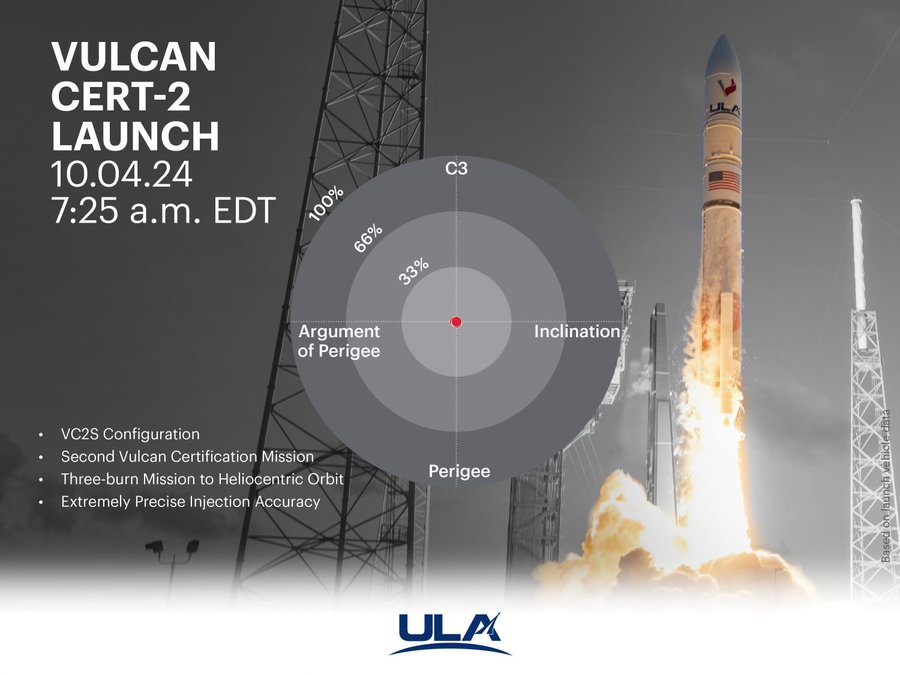Although the second test flight (CERT-2) of the United Launch Alliance (ULA) Vulcan Centaur rocket was successful, it was not without incident.
Initially held up by temperature measurements that were out of range, the launch was authorised to go ahead after dawn had broken. ULA’s Vulcan Centaur, in a VC2S (two solid rocket boosters plus short fairing) configuration, lifted off at 1125 GMT on 4 October from Cape Canaveral, Florida. It successfully placed its Centaur upper stage and mass simulator payload into the target LEO holding orbit. These were later fired into a heliocentric orbit.

Vulcan Centaur CERT 2 launch. Courtesy: ULA
However, it was not all smooth sailing. During launch at just T+37 seconds, one of the GEM 63XL solid rocket boosters (SRB-1), built by Northrop Grumman, appeared to suffer damage to its nozzle. This caused an abnormal plume, part of which appeared to issue from the rocket.
The SRBs fell over 25 seconds later than expected from the Blue Origin BE-4 engine pair core, powered by liquid oxygen (LOX)/liquid methane. The core stage and the Centaur V upper stage, fuelled by LOX/liquid hydrogen, made up for any steering and performance/thrust shortfall to achieve its targeted parking orbit and final trajectory.
This footage https://x.com/i/status/1842173022792299003 from D. Wise/NSF shows an SRB nozzle part departing from the rest of the rocket.
What is at stake?
ULA has tens of launch contracts from the US government and military on the line, but Vulcan Centaur must pass stringent certification tests before it can fly and before its operator can fulfil those orders. The CERT-2 test flight of the rocket represented the second certification flight for US government launches. ULA has already declared it a success and if officials agree after reviewing the flight data, the Vulcan Centaur rocket could be cleared for US national security missions within weeks.
ULA achieved the first certification with the largely successful CERT-1 launch of Vulcan Centaur, which carried the Peregrine lunar lander (the landing mission was later scuppered by the rupture of an oxidiser tank aboard the craft) in January.
The high stakes perhaps explain why the second test flight was such a crucial milestone for ULA, and why it was willing to bear the total cost of the demonstration mission since it carried nothing of consequence. CERT-2 was supposed to carry the Dream Chaser space plane built by Sierra Space. It would have marked the robotic plane’s first flight but the Dream Chaser was not ready in time. Instead, Vulcan Centaur lifted a much less glamorous 1.5 metric ton inert mass.
Comment by David Todd:
ULA’s CEO Tory Bruno was a little coy about releasing detailed information on the targeted and achieved orbits. However, the company’s Bullseye launch result chart, with C3 (Characteristic Energy) as one of its parameters, signalled that the launch was accurate.
As such, we at Slingshot Aerospace’s Seradata team will give ULA the benefit of the doubt and mark this launch as a success. Its successful achievement of orbit is a testament to the robustness of the Vulcan Centaur rocket and its thrust vectoring systems.
Some, however, have wondered why ULA has been treated so kindly by launch authorities such as the FAA, given that the regulator has grounded most launches of the SpaceX Falcon 9 because of an anomaly related to its upper stage de-orbit firing.

CERT-2 launch Bullseye plot shows its apparent accuracy. Courtesy: ULA








